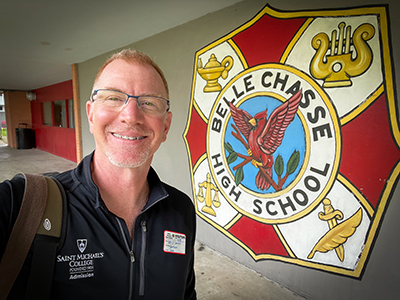Playhouse looks to strong next act in 2022 after pandemic intermission
Local historian tells the interesting story of a Saint Michael's institution that dates back to the 1940s and several venues before it settled into the McCarthy Arts Center
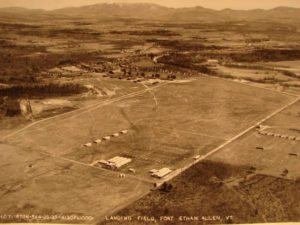
Aeriel view the building that became Austin Hall, back when it was on the Fort Ethan Allen property.
Bob Blanchard is administrator of the extremely popular (13,600 members!) Facebook Group called Burlington-Area History, and recently he posted one of his characteristically well-researched and well-written historical accounts, this one about the Saint Michael’s Playhouse and its interesting long history. In this year when local community members are, for a second straight summer, missing a canceled Playhouse season because of the COVID-19 pandemic, Bob’s account felt like a timely feature to share with the wider Saint Michael’s audience. Here is his post:
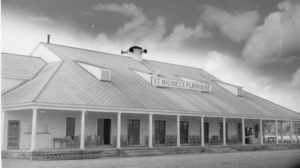 Saint Michael’s Playhouse mounted their first season in 1947, housed in what was known as Austin Hall. This building, like many on the campus at that time, had been moved from Fort Ethan Allen after the war. Austin Hall was no doubt the largest building that made the move across the open fields separating the fort and the campus. The attached 1935 aerial of the fort’s aircraft landing field shows where that first playhouse building originally sat at the fort. It’s the structure in the lower left corner of the landing field.
Saint Michael’s Playhouse mounted their first season in 1947, housed in what was known as Austin Hall. This building, like many on the campus at that time, had been moved from Fort Ethan Allen after the war. Austin Hall was no doubt the largest building that made the move across the open fields separating the fort and the campus. The attached 1935 aerial of the fort’s aircraft landing field shows where that first playhouse building originally sat at the fort. It’s the structure in the lower left corner of the landing field.
Like most of the wood frame structures at the fort, Austin Hall was not original to the fort. I couldn’t pinpoint exactly when it was constructed, but seems to have been in the 20s. It was built as what was known as a hospitality house, to house receptions, dances and the like.
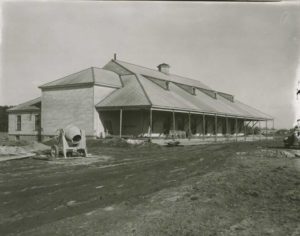
In 1946 the large structure was moved intact and set up on a new foundation. The photo with the cement mixer was taken near the end of this process. Until the college’s chapel was built, Austin Hall was the only building on campus in which the entire campus community could gather for mass. A photo of a performance inside this building is also attached. The east side of this building featured seven French doors and chairs and tables were set up on the covered porch on that side. From there patrons could enjoy the sweeping views that can be seen across route 15 from the campus.
In 1960 the playhouse lost its home when the first Austin Hall had to be removed to make way for the new Alliot Hall. The old building was dismantled and most of the lumber salvaged. This process is seen in another attached photo.
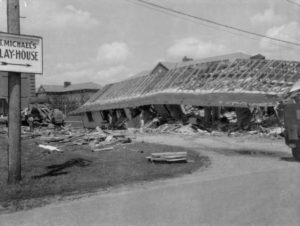
The playhouse moved into another former Fort Ethan Allen wood frame building, which was dubbed Austin Hall II. This was a former campus dining hall, no longer being used by the college. This building can be seen in another attached photo with the playhouse sign over the gable entrance with two ticket windows to the side.
For a decade the playhouse prospered in its new venue, but in 1970 the college wanted to take down Austin II as well, and it was demolished in 1971. Saint Michael’s and playhouse management, Players Inc. out of Washington D.C., could not agree on the next step in their relationship, an so the playhouse left its namesake home for a hiatus that lasted several years. Players Inc. exited the local scene after having run the playhouse for 20 years.
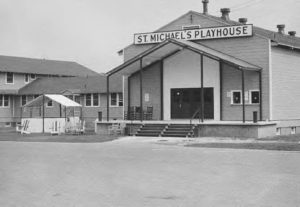
The reaction to the loss of this longtime cultural resource was such that a group of local producers was formed. Rathgeb, O’Brien and Rathgeb, was formed as the producers organization by Donald and Joanne Rathgeb and Margaret O’Brien.

They produced three plays for the 1971 season which were put on at the Marble Island resort. A combination of local veteran playhouse actors (including the producers) along with outside talent appeared in the productions. The new venture, called Cabaret Theatre at Marble Island, presented five shows for the 1972 season. It does not appear that the Cabaret Theatre continued after 1972.
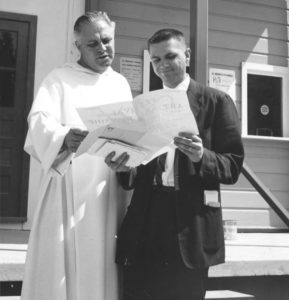
Fr. Gilbert Hartke, O.P. and Donald Rathgeb, early major figures in Saint Michael’s Playhouse history, stand outside of playhouse looking over poster.
But in 1975 the new McCarthy Arts Center opened on the Saint Michael’s campus. The Saint Michael’s Playhouse was welcomed back onto the campus with the new state of the art theater as their home. They have been there ever since, staging four high quality summer theater productions every year until the recent Covid-19 shutdowns forced the cancellation of the 2020 and 2021 seasons. Hopefully they will be back on stage next year.
Most of the photos in this post were from Saint Michael’s Special Collections.
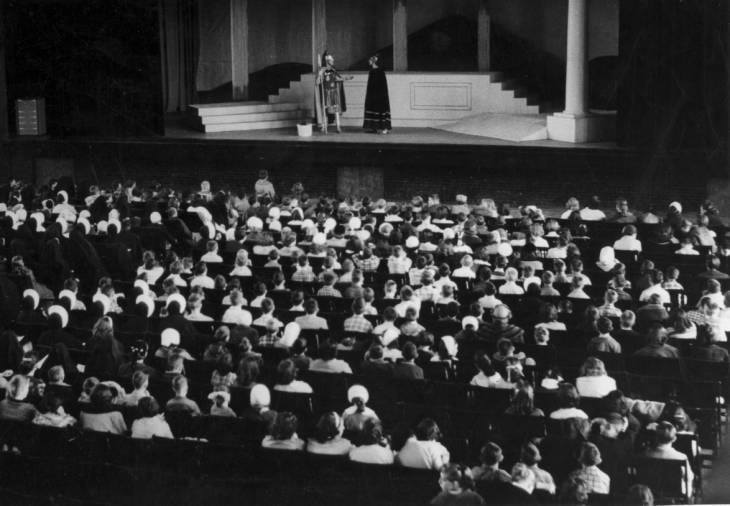
An audience inside the original Saint Michael’s Playhouse building in Austin Hall.





